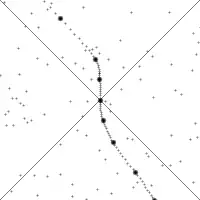The circles in geometry are the curves with
$$ x^2 + y^2 = C $$
In relativity, the analog of circles are hyperbolas:
$$ t^2 - x^2 - y^2 - z^2 = C $$
These curves, unlike circles, are disconnected hyperbolas. For any x,y,z, and positive C, there are two solutions for t, positive and negative, and they are never closer than 2C in t. The two branches of the hyperbola go up in time, and down, and define the forward and backward branch of the hyperbola.
Much as a rotation takes points around a circle, a lorentz transformation takes points along the hyperbola. Those Lorentz transformations which rotate the point continuously cannot move points from the upper hyperbola to the lower hyperbola.
Any timelike interval is either in the forward or backward hyperbola, and is either strictly to the future, or to the past. Null intervals too, by continuity.
